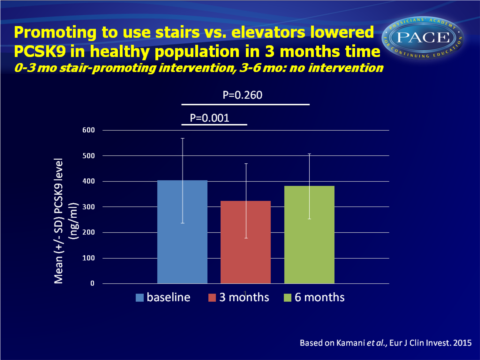Physical activity lowered PCSK9 in 3 months' time
Promoting to use the stairs instead of the elevator during 3 months lowered PCSK9 levels in a healthy population, implying that small lifestyle changes can improve PCSK9 levels.
Stairs instead of elevators at the workplace decreases PCSK9 levels in a healthy populationLiterature - Kamani et al., Eur J Clin Invest. 2015
Kamani CH, Gencer B, Monteccuco F
Eur J Clin Invest. 2015 Jun 17. doi: 10.1111/eci.12480
Background
Regular physical exercise is associated with a significant decrease of LDL-c levels and an increase of HDL-c. Many patients with hypercholesterolaemia do not reach recommended LDL-c targets despite high intensity statin therapy.Therefore, other mechanisms known to be involved in the regulation of LDL-c are being explored as therapeutic targets [1], such as PCSK9 function. Both loss-of-function and gain-of-function mutations in the gene encoding for PCSK9 have been described, and are associated with low circulating LDL-c levels and hypercholesterolaemia and associated risks, respectively [2-4]. Other mediators of PCSK9 levels and activity, such as Annexin 2, have also been reported [5].
Little is known about the impact of lifestyle on PCSK9 levels, although in obese men PCSK9 levels were found to decrease as a consequence of lifestyle interventions [6]. Whether physical activity affects PCSK9 levels in a healthy population is currently unknown. It has previously been shown that the intervention of promoting the use of stairs instead of elevators at the workplace improved CV risk factor control [7]. The current study analysed the impact of that intervention (during 3 months, followed by 3 months with no imposed recommendations) on PCSK9 serum levels, and the potential association with LDL-c changes in clinically healthy Geneva University Hospital employees. Stair use was promoted in various ways, and was self-reported in physical activity diaries as well as measured by accelerometers. None of the 61 participants took lipid-lowering medication.
Main results
- During the first 3 months, the mean accelerometer counts increased from 439.0 number/min/day to 459.6 number/min/day (P=0.085), and mean number of self-reported taken one-story staircases from 5.3 units/day to 23.1 units/day (P<0.001), while mean estimated aerobic capacity increased from 37.0 ml/kg/min to 40.4 ml/kg/min (P=0.001).
- A 6 months, aerobic capacity was persistently increased, although less pronounced than at 3 months. The self-reported number of ascended/descended one-story staircases were also still significantly increased, but accelerometer counts did not differ from baseline.
- After 3 months, mean PCSK9 serum levels had dropped from 403.6 to 324.3 ng/ml (P=0.001). Mean LDL-c significantly decreased from 3.5 to 3.3 mmol/l, and ApoB100 decreased from 1.9 to 1.8 μmol/l (P=0.008). There was a tendency for an increase in adiponectin (15.2 to 19.3 μg/ml (P=0.056). CRP and Lp(a) did not change in this period.
- At 6 months, mean PCSK9 levels did not differ significantly from baseline.
- BMI was significantly reduced at 3 months and at 6 months, as compared with baseline.
- In a multivariate model, the physical activity intervention was significantly associated with PCSK9 levels at 3 months, after correction for multiple potential confounders.
Download Kamani EJCI 2015 PACE.pptx

Conclusion
These data suggest that physical activity positively impacts PCSK9 levels in a healthy population. This implies that behaviour and lifestyle changes can inhibit PCSK9 in a 3-month period, independently of potential confounders. Thus, physical activity appears to also be cardioprotective via modulation of the PCSK9 pathway. A larger randomised study should confirm these observations. Find this article online at Eur J Clin Invest
Referenties
1. Vogel RA. PCSK9 inhibition: the next statin? Journal of the American College of Cardiology. 2012; 59(25): 2354-5.
2. Mayne J, Dewpura T, Raymond A, et al. Novel loss-of-function PCSK9 variant is associated with low plasma LDL cholesterol in a French-Canadian family and with impaired processing and secretion in cell culture. Clinical chemistry. 2011; 57(10): 1415-23.
3. Cohen JC, Boerwinkle E, Mosley TH, Jr., Hobbs HH. Sequence variations in PCSK9, low LDL, and protection against coronary heart disease. The New England journal of medicine. 2006; 354(12):1264-72.
4. Abifadel M, Varret M, Rabes JP, et al. Mutations in PCSK9 cause autosomal dominant hypercholesterolemia. Nature genetics. 2003; 34(2): 154-6.
5. Ly K, Saavedra YG, Canuel M, Routhier S, Desjardins R, Hamelin J, et al. Annexin A2 reduces PCSK9 protein levels via a translational mechanism and interacts with the M1 and M2 domains of PCSK9. The Journal of biological chemistry. 2014; 289(25): 17732-46.
6. Arsenault BJ, Pelletier-Beaumont E, Almeras N, Tremblay A, Poirier P, Bergeron J, et al. PCSK9 levels in abdominally obese men: Association with cardiometabolic risk profile and effects of a one-year lifestyle modification program. Atherosclerosis. 2014; 236(2): 321-6.
7. Meyer P, Kayser B, Kossovsky MP, et al. Stairs instead of elevators at workplace: cardioprotective effects of a pragmatic intervention. European journal of cardiovascular prevention and rehabilitation : official journal of the European Society of Cardiology, Working Groups on Epidemiology & Prevention and Cardiac Rehabilitation and Exercise Physiology. 2010; 17(5): 569-75.
